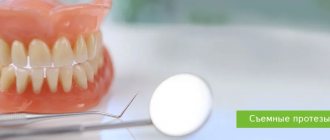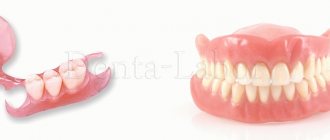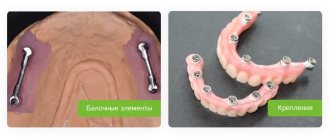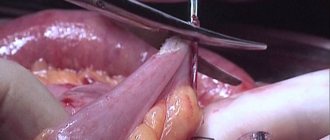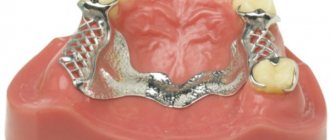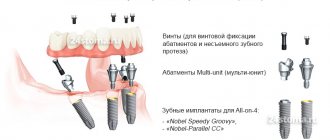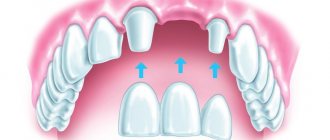People lose teeth for various reasons - due to injuries, advanced dental diseases. And of course, the problem of a lost tooth needs to be solved urgently, and not only because the absence of a tooth in a row is unaesthetic. The absence of teeth can lead to the development of bite defects, pathologies of the gastrointestinal tract, and cause the appearance of premature wrinkles. Modern dentistry is ready to offer patients different options for restoring lost teeth - prosthetics or implantation. But preparation for the installation of dentures or implantation of implants takes time, and so that a person does not have to go without a tooth all this time, a special removable denture can be installed in the area of the defect - a butterfly.
What is a butterfly prosthesis, in what cases is its installation indicated, what types of butterflies exist, what is the price for installing this type of orthopedic structure - we will tell you about this in our article.
Butterfly denture – why is it called that?
The butterfly denture got its name due to the similarity of its soft base to the wings of a butterfly. Of course, such similarity can be called conditional, since the shape of the prosthesis depends on the number of artificial teeth and the length of the supporting part. With a large loss of teeth in one jaw, the design turns into a clasp prosthesis on attachments and no longer resembles a butterfly: this is why it is customary to call only mini-prostheses for replacing one or two teeth.
The butterfly prosthesis is fixed in the mouth using clasps - special hooks that extend from the base of the structure: they are usually made of soft transparent plastic and tightly grip the supporting teeth.
Stages of prosthesis manufacturing
The process of making a butterfly takes an average of 2 weeks. The process will be faster if the patient still has a tooth that will have to be removed in the future. In this case, an impression is taken of the problematic element and sent to the laboratory. The wizard makes a copy of the element to be removed and forms clasps according to the parameters of neighboring elements. Impressions are also made of the supporting teeth on which the clasps will be attached.
To make a prosthesis, a dental impression must be taken.
While the dentures are being made, the patient will need to remove one tooth and wait for the socket to heal. At your next dentist appointment, the butterfly will be installed. If necessary, the doctor adjusts the structure already in the patient’s oral cavity.
The butterfly prosthesis is a removable type of product. It will be possible to independently remove it from the mouth to carry out the necessary hygiene measures.
When is a removable butterfly denture suitable?
As already mentioned, a removable butterfly denture is installed when it is necessary to replace one or two teeth. Most often this occurs after the implantation procedure, when it is necessary to replace the empty space while the implant is healing. First of all, this concerns the frontal zone, where aesthetics are important (do not walk around with a gaping hole instead of a front incisor). A butterfly denture for the front tooth is considered one of the most common removable structures when performing implantation in the aesthetic zone, but one should not think that when restoring molars and premolars, a temporary butterfly denture is not needed at all. The fact is that the loss of even one tooth seriously affects the functioning of the entire dentofacial apparatus. Firstly, the chewing load is not distributed correctly, which can lead to problems with bite and gastrointestinal tract (due to poor chewing of food). Secondly, neighboring teeth begin to shift to fill the missing space, so in the absence of a replacement prosthesis, the entire dentition slowly shifts, which can subsequently seriously complicate treatment. A butterfly partial denture solves these problems.
The only thing that such a prosthesis will not save from is bone tissue atrophy, which begins to occur after tooth extraction, but this problem is solved after the implantation of a titanium implant.
Types of butterflies depending on the purpose of installation
Removable butterflies are most often installed to eliminate single, less often multiple, defects. In exceptional cases, the species in question can be used to restore the lower or upper jaw.
Butterflies can only be installed on a full jaw on a temporary basis, for example, while preparing for implantation. The main purpose of the device is to correct existing cosmetic imperfections in the smile line. While wearing the structure, it is advisable to avoid solid foods and visit a doctor in a timely manner.
A butterfly will be more appropriate in cases where one unit has suffered. In this case, the hole is covered with a prosthesis, and special wings of the product are attached to the adjacent surviving teeth. At the same time, the clasps do not affect the gums and do not have a negative effect on the mucous membranes of the mouth. A butterfly denture for one tooth is suitable for both temporary and permanent wear. The material of the product is selected by the dentist taking into account the type of problem the patient has and his preferences.
Pros and cons of butterfly dentures
The quality of a butterfly prosthesis directly depends on its material and the professionalism of the specialists who will install this structure. In general, a temporary butterfly prosthesis has two key advantages, due to which this design has been widely used in dentistry for a long time.
- Replacement of the chewing function of the tooth. It is better not to subject a removable denture to heavy loads, but it copes quite well with chewing regular food.
- Not bad aesthetics. Modern designs (especially the nylon butterfly prosthesis) provide a very decent aesthetic result. When using transparent clasps, the butterfly prosthesis will not be visible on the gums.
However, it should be understood that a complete tooth replacement cannot be carried out using this type of prosthesis. The butterfly prosthesis also has a number of disadvantages that many patients have to put up with while wearing it. All the pros and cons of this type of prosthetics are outlined in the table below.
- No grinding of teeth.
To install a butterfly denture, you do not need to grind down adjacent teeth. - Easy care.
The structure must be washed with running water and cleaned with a brush, and placed in a special solution overnight. - Low cost.
We will tell you more about how much a butterfly prosthesis costs below.
- Difficulties with adaptation.
Immediately after installation of a butterfly prosthesis, problems with diction and discomfort when biting may occur. - Fragility.
This prosthesis breaks quite easily and does not have a long service life. - Allergic reaction.
When installing dentures made of acrylic and plastic, allergic reactions are possible.
Are there any alternatives?
Of course, modern dentistry can offer alternatives to butterfly dentures. Instead of this type of prosthesis, the following can be installed:
- Plate dentures, which are also fixed on the supporting teeth using special hooks;
- Clasp dentures. Their peculiarity is the presence not only of clasps, but also of a special arc. Clasps stay firmly in the oral cavity, but their price will be higher than the cost of a butterfly prosthesis.
What type of prosthesis should I choose for temporary or permanent removable prosthetics? Only an orthopedic dentist can answer this question after examination and diagnosis.
Removable butterfly prosthesis – price in Moscow
The price of a butterfly denture, like all structures of this type, is not fixed. The cheapest samples cost an average of 3,000 – 5,000 rubles, but they are not always of high quality, which significantly affects the patient’s comfort. Budget prostheses are usually made of fairly hard plastic, which does not look very aesthetically pleasing and can also cause discomfort and even pain when worn. The price of a removable butterfly prosthesis made of nylon in Moscow dentistry will be more expensive (from 12,000 to 20,000 rubles for the most modern designs), however, from both a functional and aesthetic point of view, such systems are much more effective.
Contraindications
Butterflies have virtually no restrictions on installation, with rare exceptions. It is not recommended to use structures if the jaws are toothless or if the crowns of the elements located next to the defect are partially damaged. Another contraindication to the use of the structure is inflammatory diseases of the oral cavity. In this case, it can aggravate the course of the pathology and cause more dangerous complications.
Dentists do not attach the butterfly to adjacent elements that exhibit mobility. The last prohibition against butterfly prosthetics is severe depletion of the jaw bone tissue. Before the procedure, it is recommended to restore the jaw structures through surgery.
Do I need to remove dentures at night?
Modern “removers” can be worn constantly and it is not necessary to remove them at night – especially during the first 2-3 weeks, while adaptation to the designs occurs. However, outside the oral cavity, dentures with a plastic base should NOT be placed in a humid environment, since favorable conditions are created for the development and growth of pathogenic microflora. This can lead to bleeding and gum inflammation.
If there are metal elements, the prosthesis must also not be stored in tap water, especially chlorinated water - this can lead to metal corrosion.
For storage and transportation, it is necessary to use specially designed protective ventilated boxes/cases in which the prosthesis will be kept clean and dry.
Give up removable dentures forever! Consultation + diagnosis + treatment plan FREE. Find out which dental implantation method is right for you in 1 day!
Enroll now
Care
Caring for a prosthesis is not difficult, the main thing is to carry out all procedures in a timely and regular manner. The materials from which the product is made are considered unfavorable for the proliferation of pathogenic flora and do not react chemically with saliva.
Hygienic measures for the butterfly are necessary in order to extend the life of the prosthesis and maintain its original appearance:
- The basic rule that must be followed when caring for the structure is to remove the denture after each meal to clean it of plaque and food debris. The structure is treated with antiseptic solutions once a day.
- After installing the device, you may experience problems eating and speaking for the first few days. In order to quickly get rid of discomfort, you need to communicate more with others. Also, at first you should take off and put on the structure in front of a mirror. After a certain time, all actions to secure the prosthesis in place will become automatic.
- To prevent the appearance of the butterfly from being damaged, you need to stop consuming solid foods. You should also control the number of portions entering the oral cavity at one time: they should not be too large.
Cost of dental restoration
How much does a denture cost for one tooth? In Moscow and the regions, the price of an immediate prosthesis averages 6000-7000 rubles, and a splinting clasp prosthesis costs from 60 thousand rubles. Also, before prosthetics, it is necessary to undergo the removal of tartar and plaque, treatment of existing caries, pulpitis, stomatitis - all these procedures are paid separately.
[1] Abolmasov N.G. Orthopedic dentistry, 2002.
Author: Sambuev B. S. (Thank you for your help in writing the article and the information provided)
Dental prosthetics at the President clinic
Do you want to get a prosthesis, but are you afraid of pain? At the President clinic, prosthetics are done quickly and completely painlessly!
More than a million people have become our patients, and here's why:
- modern techniques and materials;
- specialists of the highest category;
- innovative equipment;
- personalized approach;
- physical and psychological comfort during procedures;
- several anesthesia options;
- convenient location - branches in all districts of Moscow.
Don’t put off your health for later, call right now to make an appointment and restore lost teeth in just a few days!
Reviews
Anna, 45. Installed the butterfly 3 years ago. What attracted me most was the aesthetic appearance of the structure and its price. I noticed no disadvantages from wearing the device: the smile was natural, there were no difficulties when eating food. The only disadvantage of the prosthesis is the possibility of breakage when eating solid food, for example, apples or crackers. In this case, you will have to install a new structure.
Igor, 41 years old. A regular plastic prosthesis did not suit me because it quickly lost its original external characteristics. Damage to the product occurred despite careful care. 2 months after installation, the surface of the prosthesis began to darken and differ from natural teeth. Professional cleaning of the structure also helped for a short time. Ultimately, I had to make a choice in favor of an expensive type of prosthetics.
Adelina, 34. I was unhappy with the butterfly prosthesis. The disadvantages of the product are the constant entry of food under the denture, irritation of the gums, and the need for regular maintenance. For me, this method of restoring the aesthetics of the dentition turned out to be ineffective.
Nylon immediate dentures
Nylon dentures are soft, flexible, and elastic. They are very comfortable, do not require long adaptation, and within a few hours after installation you will forget about them and stop noticing them.
Nylon structures are as close as possible to natural fabrics and look just like real crowns and gums. For this reason, it is recommended to install nylon dentures in the smile area.
They do not rub the soft tissues of the oral cavity, are easy to put on, and are firmly fixed. When installing them, the risk of injury is eliminated, which guarantees the absence of inflammation and gum disease.
Nylon is a material that does not contain metals or monomers, and therefore does not provoke allergies. It is easy to clean and is not a favorable environment for the growth of germs and bacteria. Prostheses based on it are as hygienic as possible.
When chewing hard food, nylon structures can become deformed and require careful use. They are somewhat more expensive in price than their acrylic counterparts, but this is compensated many times over by their convenience and practicality.
Indications for installation of a prosthesis
The main purpose of the design is to restore one or two incisors followed by bridge prosthetics or before implantation. Contraindications may include:
- the incisors that will serve as a support for the structure have serious damage (carious lesions, erosion, damage to tooth enamel, etc.)
- the presence of inflammatory processes in the cavity;
- in cases where the jaw arch has a deformation or anomaly in development;
Installation of the structure is possible, but only after these problems have been treated.
